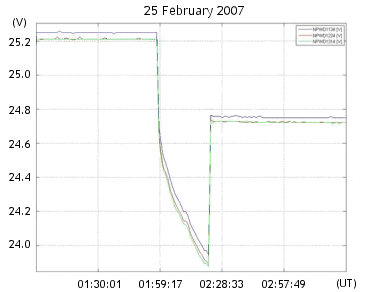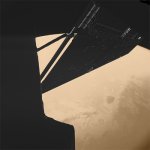No. 76 - Successful Mars Swing-by
The navigation campaign for the Mars swing-by has been successfully completed and will continue now with the preparation of the Deep Space Manoeuvre 3 planned for the end of April 2007. Together with this manoeuvre, Rosetta is now correctly phased for the Earth swing-by in November this year.
A total of 11 New Norcia (NNO) passes (6×8h commanding, 4×12h commanding, 1×4h tracking only) and 9 NNO/Cebreros DDOR measurements were taken during this period.
Support from NASA DSN stations during the reporting period consisted of 13×4h tracking passes and 9 DDOR measurements. Tracking passes in the 24 hours around the Mars swing-by have also been taken for monitoring and data downlink purposes.
| DOY | Date | Pass | Main Activity |
| 43 | 12.02.07 |
DSS-24 |
Clean-up of Waited Events List (WEL). Luminance threshold update for Sun Acquisition Sensors (SAS) |
| 46 | 15.02.07 | NNO 1083 | Batteries charging |
| 47 | 16.02.07 | NNO 1084 | Monitoring |
| 49 | 18.02.07 | NNO 1086 | Monitoring |
| 50 | 19.02.07 | NNO 1087 | Monitoring |
| 51 | 20.02.07 | NNO 1088 | Mars swing-by timeline uplink |
| 52 | 21.01.07 |
NNO 1089 |
Monitoring and wheel off-loading (WOL) |
| 53 | 22.01.07 | NNO 1090 | Payloads activation for Mars swing-by and lander Philae Go/NoGo |
| 54 | 23.02.07 | NNO 1091 | Instruments calibration for Mars swing-by |
| 55 | 24.02.07 |
DSS-54 |
Mars observations |
| 56 | 25.02.07 | DSS-54 | Monitoring |
At the end of the reporting period (DOY 056) Rosetta was at 315.3 million km from Earth (2.10 AU; one-way signal travel time was 17 minutes 32 seconds). The distance to the Sun was 216.6 million km (1.44 AU).
Mars Swing-by Operations
Overview of spacecraft operations key events during the Mars swing-by (MSB), with times in UT:
| 24 February 2007 - DoY 55 | |
| 17:18:12 | Start slew for pre-MSB observation, Telemetry loss |
| 18:03:12 | End slew for pre-MSB observation, Telemetry back. Start of observation |
| 22:13:12 | End of observation. Start slew to GSEP (Gyrostellar Ephemeris Phase), Telemetry loss |
| 22:58:12 | End slew to GSEP, Telemetry back |
| 23:13:01 | Start slew to Closest Approach attitude |
| 23:33:01 | End slew to Closest Approach attitude |
| 25 February 2007 - DoY 56 | |
| 00:58:12 | All Rosetta payloads OFF |
| 01:08:12 | X-band transmitter OFF, Telemetry loss. S-band carrier stays |
| 01:56:10 | Occultation start, S-band carrier lost |
| 01:57:59 | Closest Approach. Altitude was 250.6 km above Mars's equatorial radius with a 3-sigma uncertainty of 1.1 km. |
| 01:58:10 | Eclipse start |
| 02:10:35 | Occultation end, S-band carrier back |
| 02:22:59 | Eclipse end |
| 02:31:01 | X-band transmitter ON (4 minutes warm-up) |
| 02:31:01 | Switch ON of Antenna Pointing Mechanism Electronics (APME) and Solar Array Drive Electronics (SADE) |
| 02:33:01 | Start Phobos tracking |
| 02:35:01 | Telemetry signal back |
| 03:20:07 | Manual start SSMM dump, lander with priority |
Science Results
Spacecraft
Thermal
The thermal behaviour of the Rosetta spacecraft is nominal and stable. The heaters and Thermal Control Threshold (TCT) configurations were temporarily modified during the Mars swing-by in order to meet the power consumption requirements. After the swing-by the standard configuration has been re-established.
Very sharp temperature changes of the solar arrays have been recorded by the thermistors at eclipse entry and exit (-120 °C in 25 minutes at entry, and + 120 °C in 15 minutes at exit). This behaviour was unexpected and could be explained by the installation of the thermistors in a position with very limited thermal capacity.
Power
- Rosetta
The power subsystem is again in its nominal configuration and performing nominally. In preparation for the Mars swing-by, on DoY 046 the batteries end of charge level was commanded from 24.7 V to 25.2 V (100%) with a charging current of 0.95A. The discharge and recharge process during the swing-by was nominal, and the data will be further analysed off-line. The Power Conversion Unit (PCU) battery discharge alarms remained disabled from DoY 053 to doY 056 to avoid triggering during the eclipse phase of the swing-by. Since the eclipse, the batteries are at their expected terminal voltage of 24.7 volts. The trickle charge currents are at 36mA for Battery 1, 27mA for Battery 2 and 29mA for Battery 3.

Discharge of the three batteries during the eclipse which lasted from 01:58:10 to 02:22:59 (UT), and the subsequent recharge
- Lander Philae
On DoY 053, preparatory activities were performed for the lander Philae. The PI team confirmed the correct behaviour of the lander batteries thus giving the go ahead for the operations of the lander's ROMAP and CIVA instruments during eclipse.
Payload
The reporting period included the following payload activities as part of the Mars swing-by (MSB):
- Initialisations and calibrations from MSB-48h to MSB-9h
- Pre-MSB observations: 4h slot between 18:00-22:00 UT on 24 February
- Lander operations during MSB (via internal time-tagged queue)
SREM (the Standard Radiation Environment Monitor) has been operated according to the plan with a power cycling around the time Rosetta was in eclipse. In addition, operations have been conducted according to the plan for the below set of Rosetta instruments:
| Instrument | First switch ON |
| ALICE | 09.45 UT, 22 February |
| RPC | 23.58 UT, 22 February |
| OSIRIS | 21.38 UT, 22 February |
| VIRTIS | 15.04 UT, 24 February |
Post-MSB observations (Mars and Phobos tracking) started on 02:30 UT, 25 February but will be completed in the next reporting period.
Future Milestones
The Mars swing-by phase will be formally completed with the Deep Space Manoeuvre 3 to be executed on 26 April 2007 and the orbit determination following it.
The spacecraft timeline includes now a quite dense observation plan in conjunction with the New Horizon mission. The downlink of data from the Mars swing-by will continue until end of March.





